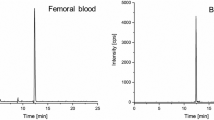Abstract
A case report of a 25-year-old man who committed suicide by intravenous injection himself of an aqueous home-made castor bean extract is presented. The patient was hospitalized and treated symptomatically and was released at its own request fourth day after intoxication. The next day, the patient’s condition deteriorated, and he died 6 days after intoxication even though he was given medical care. Case history, autopsy, and toxicological investigation of ante- and post-mortem collected materials are described. Blood and urine collected from the patient ante-mortem and other several biological materials (namely blood from the upper and lower limb, blood from the right and left ventricle, pericardial fluid, vitreous humour, liver, kidney, and spleen) were collected post-mortem during autopsy. Liquid–liquid extraction procedure followed by high-performance liquid chromatography tandem mass spectrometry analysis for identification and determination of ricinine as a biomarker of ricin/castor seed intoxication was developed and validated. The method was applied on analysis of collected ante- and post-mortem biological materials. The post-mortem contents of ricinine in organs (namely the liver, kidney, and spleen) are firstly reported. The obtained results indicated approximately uniform distribution of ricinine (concentration level about 1 ng mL−1) in the body after death. In addition, the GC-MS method was also applied for the analysis of extract of castor seed and the patient’s urine, to demonstrate alternative possibility for identification of ricinine for clinical and forensic purposes.





Similar content being viewed by others
Data availability
The authors declare that all data and materials are available from the corresponding author upon request.
References
Jena J, Gupta AK (2012) Ricinus communis Linn: a phytopharmacological review. Int J Pharm Pharmaceutical Sci 4:25–29
Mutlu H, Meier MAR (2010) Castor oil as a renewable resource for the chemical industry. Eur J Lipid Sci Technol 112:10–30. https://doi.org/10.1002/ejlt.200900138
Audi J, Belson M, Patel M, Schier J, Osterloh J (2005) Ricin poisoning. JAMA 294:2342–2351. https://doi.org/10.1001/jama.294.18.2342
Bradberry SM, Dickers KJ, Rice P, Griffiths GD, Vale JA (2003) Ricin poisoning. Toxicol Rev 22:65–70. https://doi.org/10.2165/00139709-200322010-00007
Spivak L, Hendrickson RG (2005) Ricin. Crit Care Clin 21:815–824. https://doi.org/10.1016/j.ccc.2005.06.006
European Pharmacopoeia, 6th edition, Vol. 2, 01/2008, Monograph of castor oil virgin, castor oil hydrogenated and castor oil refined
Kopferschmitt J, Flesch F, Lugnier A, Sauder P, Jaeger A, Mantz J (1983) Acute voluntary intoxication by ricin. Hum Toxicol 2:239–242. https://doi.org/10.1177/096032718300200211
Doan LG (2004) Ricin: mechanism of toxicity, clinical manifestations, and vaccine development. A review. J Toxicol Clin Toxicol 42:201–208. https://doi.org/10.1081/CLT-120030945
Challoner KR, McCarron MM (1990) Castor bean intoxication. Ann Emerg Med 19:1177–1183. https://doi.org/10.1016/S0196-0644(05)81525-2
Wedin GP, Neal JS, Everson GW, Krenzelok EP (1986) Castor bean poisoning. The Am J Emerg Med 4(3):259–261. https://doi.org/10.1016/0735-6757(86)90080-X
Kalb SR, Barr JR (2009) Mass spectrometric detection of ricin and its activity in food and clinical samples. Anal Chem 81:2037–2042. https://doi.org/10.1021/ac802769s
Godal A, Olsnes S, Pihl A (1981) Radioimmunoassays of abrin and ricin in blood. J Toxicol Environ Health 8:409–417. https://doi.org/10.1080/15287398109530079
Johnson RC, Lemire S, Woolfitt AR, Ospina M, Preston KP, Olson CT, Barr JR (2009) Quantification of ricinine in rat and human urine: a biomarker for ricin exposure. J Anal Toxicol 29:149–155. https://doi.org/10.1093/jat/29.3.149
Worbs S, Köhler K, Pauly D, Avondet MA, Schaer M, Dorner MB, Dorner BG (2011) Ricinus communis intoxications in human and veterinary medicine—a summary of real cases. Toxins (Basel) 3:1332–1372. https://doi.org/10.3390/toxins3101332
Darby SM, Miller ML, Allen RO (2001) Forensic determination of ricin and the alkaloid marker ricinine from castor bean extracts. J Forensic Sci 46:1033–1042
Coopman V, De Leeuw M, Cordonnier J, Jacobs W (2009) Suicidal death after injection of a castor been extract (Ricinus cummunis L.). Forensic Sci Int 189:e13–e20. https://doi.org/10.1016/j.forsciint.2009.04.019
Røen BT, Opsats AM, Haavind A, Tønsager J (2013) Serial Rricinine lLevels in sSerum and uUrine after rRicin iIntoxication. J Anal Toxicol 37:313–317. https://doi.org/10.1093/jat/bkt026
Carlier J, Guitton J, Romeuf L, Bévalot F, Boyer B, Fanton L, Gaillard Y (2015) Screening approach by ultra-high performance liquid chromatography–tandem mass spectrometry for the blood quantification of thirty-four toxic principles of plant origin. Application to forensic toxicology. J Chromatogr B 975:65–76. https://doi.org/10.1016/j.jchromb.2014.10.028
Peters FT, Drummer OH, Musshoff F (2007) Validation of new methods. Forensic Sci Int 165:216–224. https://doi.org/10.1016/j.forsciint.2006.05.021
Hartmann C, Smeyers-Verbeke J, Massart DL, McDowall RD (1998) Validation of bioanalytical chromatographic methods. J Pharm Biomed Anal 17:193–218. https://doi.org/10.1016/s0731-7085(97)00198-2
Matuszewski BK, Constanzer ML, Chavez-Eng CM (2003) Strategies for the assessment of matrix effect in quantitative bioanalytical methods based on HPLC−MS/MS. Anal Chem 75:3019–3030. https://doi.org/10.1021/ac020361s
Author information
Authors and Affiliations
Corresponding author
Ethics declarations
Conflict of interest
The authors declare that they have no conflict of interest.
Informed consent
Informed consent was obtained from next of kin.
Additional information
Publisher’s note
Springer Nature remains neutral with regard to jurisdictional claims in published maps and institutional affiliations.
Rights and permissions
About this article
Cite this article
Staňková, M., Handlos, P., Švidrnoch, M. et al. Fatal intoxication by intravenous injection of castor bean (Ricinus communis L.) extract—a case study. Int J Legal Med 134, 2133–2141 (2020). https://doi.org/10.1007/s00414-020-02340-x
Received:
Accepted:
Published:
Issue Date:
DOI: https://doi.org/10.1007/s00414-020-02340-x




